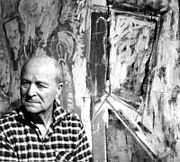Joseph Zaritsky
| Yosef Zaritsky | |
|---|---|
 | |
| Born |
September 1, 1891 Ukraine |
| Nationality | Israeli, Jewish |
| Field | Painting |
| Training | Art Academy, Kiev |
| Movement | Israeli art |
Joseph Zaritsky, also known as Yossef, (Hebrew: September 1, 1891 – November 30, 1985 ;יוסף זריצקי ) was an Israeli painter.
Biography


Zaritsky was born in 1891 in Ukraine, then part of the Russian Empire. He lived in Amsterdam, Paris and Brussels, but mostly he lived in Jerusalem. He studied at the art academy in Kiev before emigrating to Mandate Palestine in 1923. In 1929, he relocated from Jerusalem to Tel Aviv, where he became involved in the city's cultural life while documenting its scenes in his paintings.[1] Between the years 1944–47 lived in Zikhron Ya'akov. In 1948, he was Chairman of the Association of Painters and Sculptors.
For over 20 years he worked in watercolours, which he first exhibited at an exhibition jointly with the sculptor Avraham Milkov, at the Tower of David in Jerusalem in 1923, making a notable impact and evoking great interest.[2]
After his arrival in Palestine in 1923, it did not take long for Yossef Zaritsky to become one of the country's leading artists and critics, earning acclaim for his singular interpretation of the watercolors of Paul Cézanne and the Russian symbolist Vroubel. Between 1932 and 1933 he opened a studio in the cellar of his home in Rehov Mapu, Tel Aviv. Standard bearer of the Universalists in their conflict with the Orientalists, he led the "New Horizons" group which grew out of the confrontation. In this perspective, his watercolors were seen as a milestone on the road to modernism. His watercolor portraits and still lifes of the late 1920s and the 1930s reflect the influence of the French Intimists, and sometimes of Matisse.
From the mid-1930s to the mid-1940s he concentrated on one facet of the urban landscape, exploring the problems of painting in hundreds of watercolors of Tel Aviv rooftops, seen from his own roof and studio window. Gradually flatness and abstraction took over, marking these works as a milestone both in Zaritsky's development and, because of their high quality, in the art of the country. Watercolor, popular among Eretz Israel artists both as the cheapest and the most suitable medium for conveying the transparency and light of the country, was the medium preferred by Zaritsky and many artists he influenced. Among his students were Abramović, Krize, Aroch, and Holzmann.
The Kibbutz Yehiam series of oils and watercolors that Zaritsky created when he was teaching there in 1947–1949 constitute a central chapter in his work. Here, we find the first example in Israel of lyrical abstraction, with its solid and amorphous structure, unity of color, material, and form, its restrained Expressionism, and its light coloration. The high quality of the paintings, and the depth of their expression of human experience, all mark these works as a milestone in Israeli art. In the early 1950s Zaritsky's paintings became more abstract and their subjects harder to decipher.
From 1970 until his death in 1985, he lived in kibbutz Tzova, on the outskirts of Jerusalem.

Photographer: Stanley I. Batkin
Gallery
-

Untitled, 1964
Israel Museum Collection
B67.0789 -

Safed, ca. 1924
Israel Museum Collection
B69.0313 -

Paris, 1954
Israel Museum Collection
B87.0249 -

Painting, 1964
Israel Museum Collection
B67.0599 -

The Painter and the Model, 1949
Israel Museum Collection
B74.0036
Education
- 1914 Art Academy, Kiev
Teaching
- 1932-33 Opened studio in the cellar of his home in Rehov Mapu, Tel Aviv
Awards and prizes
- 1942 Dizengoff Prize for painting [3]
- 1959 Israel Prize, in painting.[4]
- 1967 Sandberg Prize for Israeli Art, Israel Museum, Jerusalem
- 1982 Yakir Tel Aviv-Jaffa
- In 2005, he was voted the 196th-greatest Israeli of all time, in a poll by the Israeli news website Ynet to determine whom the general public considered the 200 Greatest Israelis.[5]
See also
References
As of this edit, this article uses content from "Artist List, Information Center for Israeli Art", which is licensed in a way that permits reuse under the Creative Commons Attribution-ShareAlike 3.0 Unported License, but not under the GFDL. All relevant terms must be followed.
- ↑ Bio notes by Smadar Sheffi in Haaretz Guide, July 9, 2010: Review of the artist's show, "Every Part is a Whole," at the Gordon Gallery, Tel Aviv.
- ↑ Golcondafineart.com.
- ↑ "List of Dizengoff Prize laureates" (in Hebrew). Tel Aviv Municipality.
- ↑ "Israel Prize recipients in 1959" (in Hebrew). Israel Prize Official Site. Archived from the original on February 17, 2010 by WebCite.
- ↑ גיא בניוביץ' (June 20, 1995). "הישראלי מספר 1: יצחק רבין – תרבות ובידור". Ynet. Retrieved July 10, 2011.
External links
- Yossef Zaritsky collection at the Israel Museum. Retrieved February 2012
- "Yossef Zaritsky". Information Center for Israeli Art. Israel Museum. Retrieved February 2012.
- Art of Yossef Zaritsky at Europeana. Retrieved February 2012
Search results
- Joseph Zaritsky's works at the Gordon Gallery, Tel Aviv. Includes list of solo exhibitions.
|